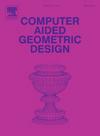A shift-invariant C12-subdivision algorithm which rotates the lattice
IF 1.7
4区 计算机科学
Q3 COMPUTER SCIENCE, SOFTWARE ENGINEERING
引用次数: 0
Abstract
In order to study differential properties of a subdivision surface at a markpoint, it is necessary to parametrise it over a so-called characteristic map defined as the infinite union of -parametrised rings. Construction of this map is known when a single step of the subdivision scheme does not rotate a regular lattice. Otherwise, two steps are considered as they realign the lattice and its subdivided version. We present a new subdivision scheme which rotates the lattice and nevertheless allows a direct construction of the characteristic map. It is eigenanalysed with techniques introduced in a companion article and proved to define a -algorithm around a face-centre. This scheme generalises Loop's scheme, allowing the designer to choose between extraordinary vertices or faces in regard to the shape of the mesh, the location of the extraordinary elements, and the aimed limit shape.

一个平移不变的c12细分算法,它旋转晶格
为了研究标记点处细分曲面的微分性质,有必要在定义为ck参数化环无穷并的特征映射上对细分曲面进行参数化。当细分方案的单个步骤不旋转规则晶格时,该图的构造是已知的。否则,在重新排列晶格及其细分版本时需要考虑两个步骤。我们提出了一种新的细分方案,它旋转晶格,但仍然允许直接构造特征映射。它是特征分析与技术介绍在同伴文章和证明,以定义一个c12算法周围的脸中心。这个方案推广了Loop的方案,允许设计师根据网格的形状、特殊元素的位置和目标极限形状在特殊顶点或面之间进行选择。
本文章由计算机程序翻译,如有差异,请以英文原文为准。
求助全文
约1分钟内获得全文
求助全文
来源期刊

Computer Aided Geometric Design
工程技术-计算机:软件工程
CiteScore
3.50
自引率
13.30%
发文量
57
审稿时长
60 days
期刊介绍:
The journal Computer Aided Geometric Design is for researchers, scholars, and software developers dealing with mathematical and computational methods for the description of geometric objects as they arise in areas ranging from CAD/CAM to robotics and scientific visualization. The journal publishes original research papers, survey papers and with quick editorial decisions short communications of at most 3 pages. The primary objects of interest are curves, surfaces, and volumes such as splines (NURBS), meshes, subdivision surfaces as well as algorithms to generate, analyze, and manipulate them. This journal will report on new developments in CAGD and its applications, including but not restricted to the following:
-Mathematical and Geometric Foundations-
Curve, Surface, and Volume generation-
CAGD applications in Numerical Analysis, Computational Geometry, Computer Graphics, or Computer Vision-
Industrial, medical, and scientific applications.
The aim is to collect and disseminate information on computer aided design in one journal. To provide the user community with methods and algorithms for representing curves and surfaces. To illustrate computer aided geometric design by means of interesting applications. To combine curve and surface methods with computer graphics. To explain scientific phenomena by means of computer graphics. To concentrate on the interaction between theory and application. To expose unsolved problems of the practice. To develop new methods in computer aided geometry.
 求助内容:
求助内容: 应助结果提醒方式:
应助结果提醒方式:


